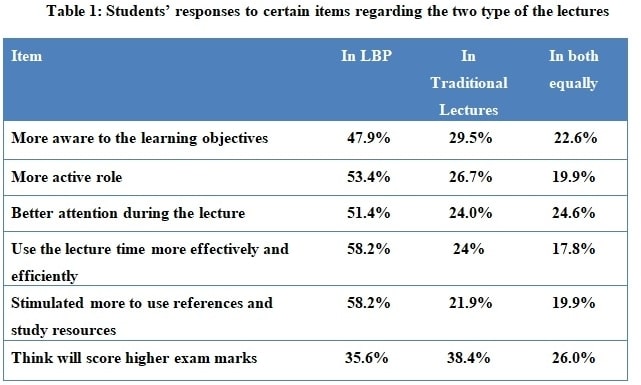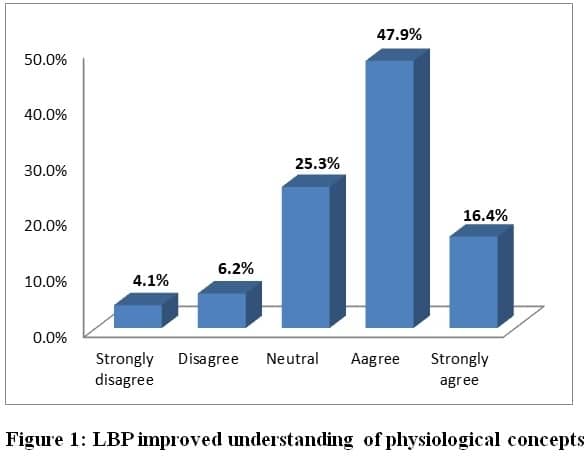Lectures are one of the most common teaching methods in medical education. Didactic lectures were perceived by the students as the least effective method (1). Teaching methods that encourage self-directed learning can be effective in delivering core knowledge leading to increased learning (2). Problem based learning (PBL) has been introduced as an active way of learning but it has some obstacles in developing countries where the intake is huge with minimum resources. This study introduces a new teaching approach: lectures based on problems (LBP) and evaluates its effectiveness compared to traditional lectures (TL) in physiology teaching. LBP and TL were applied in physiology teaching of medical students at University of Science and Technology during their study of introduction to physiology and respiratory physiology courses. Equal number of lectures was given as LBP and as TL in each course. In the steps of LBP a clinical problem is introduced to the whole class. Students in pairs analyze the problem for key words suggesting generally what the problem about and they share with the whole class what they have worked out. Students formulate learning objectives based on the scenario, and each pair of students should write down at least two learning objective. Then the instructor conducts a lecture and cover the intended objectives. The objectives of the problem can be achieved in more than one lecture with reference to the same problem. Later, in the small groups tutorial the problem is discussed again and students answer some questions based on the scenario. At the start of the next lecture, students are given quizzes on the previous one; answers are shared with the class. Students were given quizzes at the end of each course which were used to compare the effectiveness of the two types of lectures. A questionnaire was used to assess students’ satisfaction about LBP and the effect of the two methods on the students’ attitude and practice towards learning physiology. Results showed that in LBP the students have better attention (P= 0.002) and more active role (P= 0.003) than in TL. Higher percentage of students think that LBP stimulated them to use references more (P= 0.00006) and to use the lecture time more effectively (P= 0.0001) compared to TL. However, there was no significant difference between LBP and TL in the awareness of the learning objectives. About 64% of students think that LBP is more enjoyable and it improved their understanding of physiology concepts. Comparison of the students’ quiz marks showed that the means of the students’ marks in the introduction to physiology and respiratory courses were higher in the quizzes of LBP than in TL with a significant difference between them ((P=.000), (P=.006) respectively. These results suggest that LBP is an effective and active learning method that achieved some of the objectives of PBL with the minimum resources and it can be used to improve the effectiveness of the lectures.
Physiology 2019 (Aberdeen, UK) (2019) Proc Physiol Soc 43, C019
Oral Communications: Comparison of the effectiveness of lectures based on problems and traditional lectures in physiology teaching in Sudan
N. A. Alaagib1, O. A. Musa2, A. M. Saeed1
1. Department of Physiology, Faculty of Medicine University of Khartoum, Khartoum, Khartoum, Sudan. 2. Department of Physiology, The National Rebat University, Khartoum, Khartoum, Sudan.
View other abstracts by:
Where applicable, experiments conform with Society ethical requirements.


